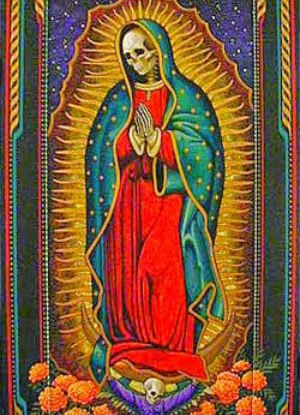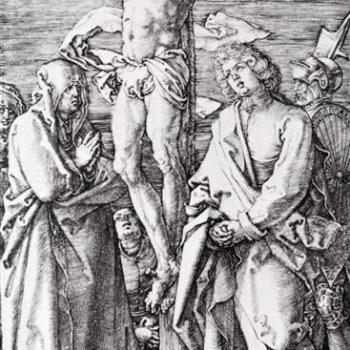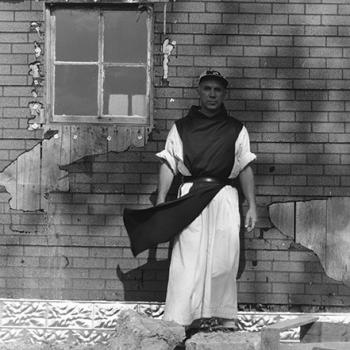I find myself thinking of folk religions today. And especially I’m reminded in the moment of Santa Muerte, Saint Death, or Holy Death, or most formally Our Lady of the Holy Death. I’ve written of her before, and I’m drawing on some earlier thoughts here gathered together with some thoughts about our human condition and how we engage it.
I admit while I am fascinated with religions, until relatively recently I’ve pretty much ignored this spiritual phenomenon right in my own backyard. And, additionally, what attention I’ve given the cult, it has been accompanied with some slight revulsion.
After all the cult of Saint Death is sometimes called the religion of the cartels and most of all of prison gang members. She is of particular interest to prisoners. And of their families. To make matters worse, there have been rumors of human sacrifice. Frankly, I think some of these stories are true.
Here’s a clip from that hostile perspective from Al Jazeera…
The religion does have roots in the criminal underworld. But. Something has emerged that appeals to the lost and left behind. And, so, despite repeated and vociferous condemnation from the Roman Church and others her cult has spread throughout Mexico and now well into the American Southwest.
Some see her as a modern incarnation of the Aztec goddess Mictecacihuati. I think in some ways this is true. There are pretty astonishing similarities. And, she is rather more than a “saint,” rather more a full on deity. Santa Muerte is the personification of death. And with that a figure of enormous power.
Me, I see her most as an indigenous American corollary to the Hindu Kali. And more than that. I’m wary of any casual use of the term “archetype.” But. Whatever the historic roots, she seems to be a manifestation of some deep sense of the human heart. There is, as I’ve noted, little in this life as powerful as death. And in the face of terrible poverty and death, of course, of course, she would become the deity to whom many might turn.
As an example, here’s a more sympathetic clip…
The unsettling figure, the skeleton of a woman, is the central visual image. But. She arises as a figure to help the lost and forgotten. And, with that she has a large and growing following. According to the Wikipedia article about Saint Death and her followers:
“The cult of Santa Muerte is present throughout the strata of Mexican society, although the majority of devotees are from the urban working class. Most are young people, aged in their teens, twenties, or thirties, and are also mostly female. A large following developed among Mexicans who are disillusioned with the dominant, institutional Catholic Church and, in particular, with the inability of established Catholic saints to deliver them from poverty.”
For me, it was fascinating to notice how much she has a lot in common with Kali. After all, in addition to the Thugs, Kali was also the principal call into the heart for the great Nineteenth century Hindu saint Ramakrishna.
And I can’t underscore how important Ramakrishna was to me, if as a pivot figure from my childhood religion to what I would become. I’ve touched on this story on a number of occasions. It’s one of those foundations of my own spiritual life.
Until I’d discovered Ramakrishna through the writings of Aldous Huxley and Christopher Isherwood and their associates, my idea of what gods looked like was informed by my conservative Baptist upbringing modified by my father’s bare and no doubt reductionist atheism. Ramakrishna prayed constantly for a vision of his goddess, Kali, the Divine Mother. He wanted to know her as she was, desperately. I personally understood this prayer. It was my own longing from some aching place in the pit of my being, to know whether God was true, was real.
I never got that response to my prayers. But his were answered. One day unbidden, she came to him. In a vision as he watched she arose out of a river and walked toward him. As she walked the goddess swelled out in pregnancy, gave birth and then ate her child. Witnessing this he slipped into a fever of ecstasy. As a young man, really, still a boy, I was shocked that this would be a turning point in this revered saint’s life. It seemed so awful. However, I filed it away in the depths of my heart, and never completely forgot it.
Shortly after I’d left the Buddhist monastery I’d been living in for several years, I went to Oregon to visit my brother. He lived in a rural area, and I found myself at the edge of a genuine wilderness.
I sat down in the shade beside a creek. I can still taste the air from that day; I can smell the warmth and the vegetation. At the very same time the area was deeply silent and abuzz with life. Then in the midst of it all something caught my attention. On a sunny spot on a good-sized rock in the middle of the creek I watched as a large fat toad, hopped up, settled down, and sunned itself.
All was right with the universe.
What I didn’t notice until just as it struck was the snake. My heart leapt into my throat, I was frozen to the spot as I witnessed it all happen. In a bloody moment snake and frog fell behind the rock, mercifully for me, out of sight. Minutes later the snake slithered up onto the rock to the same place, with a large swelling in its middle, and lazed in the same sunny spot.
In another unbidden moment, I recalled Kali and Ramakrishna and that horrific, and now somehow for me, personally, deeply beautiful vision. I felt my heart grabbed like that snake grabbed the frog. And, more important, most important: I felt myself swallowed whole by the goddess of life and of death. I realized sitting there in the shade witnessing it all, that I, too, was swallowed by the world itself.
I think Saint Death is in some very real way, Kali.
Of course, she is fiercely opposed by the Roman Church as well as by Evangelical Christians. And others. Of course she gets very bad press. And some of it, well, it is deserved. But, she is followed by increasing numbers of people. Originally her devotees came from among the poorest of the poor, and with that those who have been imprisoned, and with that, her association with criminality. These continue to count as a major part of her following.
However, she is proving to be something more. Her devotees are beginning to count more prosperous folk who also see the hard times we are caught up within. Most interestingly is how hers is becoming a religion for Millennials. Not generally prosperous English speaking North American Millennials. So far. She is beginning to find followers among more prosperous Spanish speaking Millennials. And she has a strong following in the Spanish speaking LGBTQ community.
That last population is particularly intriguing.
Something is going on. Something powerful. It might be worthwhile noticing…
For a longer reflection on her cult, here you go.












